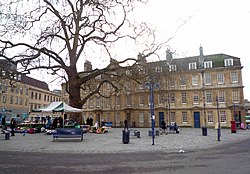Kingsmead Square, Bath
| Kingsmead Square | |
|---|---|
 |
|
| Location | Bath, Somerset, England |
| Coordinates | 51°22′52″N 2°21′47″W / 51.38124°N 2.36315°WCoordinates: 51°22′52″N 2°21′47″W / 51.38124°N 2.36315°W |
| Built | 1730s |
| Architect | John Strahan |
|
Listed Building – Grade I
|
|
| Official name: Rosewell House (number 12 to 14) | |
| Designated | 12 June 1950 |
| Reference no. | 442757 |
|
Listed Building – Grade II
|
|
| Official name: Number 5 to 10 | |
| Designated | 12 June 1950 |
| Reference no. | 442756 |
|
Listed Building – Grade II
|
|
| Official name: Number 18 | |
| Designated | 5 August 1975 |
| Reference no. | 446121 |
|
Listed Building – Grade II
|
|
| Official name: Numbers 16 and 17 | |
| Designated | 5 August 1975 |
| Reference no. | 446120 |
|
Listed Building – Grade II
|
|
| Official name: Number 15 | |
| Designated | 5 August 1975 |
| Reference no. | 446119 |
Kingsmead Square in Bath, Somerset, England was laid out by John Strahan in the 1730s. Many of the houses are listed buildings.
Number 12, 13 and 14 is made up of Rosewell House, which forms one building with Numbers 1 and 2 Kingsmead Street. The house is named after T Rosewell, who commissioned it from Strahan and whose sign, a rose and a well, can be seen on the baroque facade with the date 1736. It is a three-storey building with a mansard roof. The ground floor has been changed to include shop fronts, but a detached Ionic porch can still be seen. Dr Joseph Butler Bishop of Durham theologian, apologist, and philosopher died at Rosewell House 1752.
...
Wikipedia

